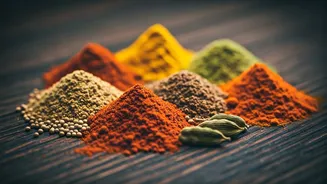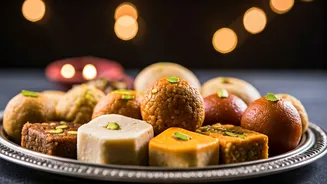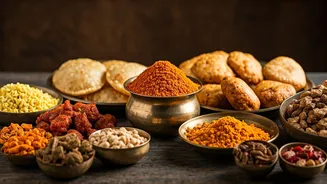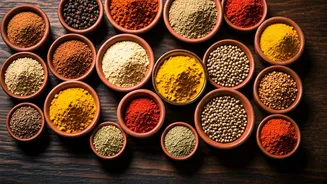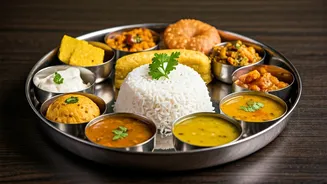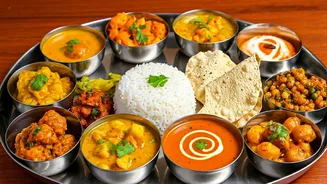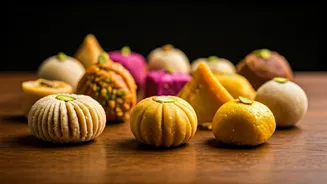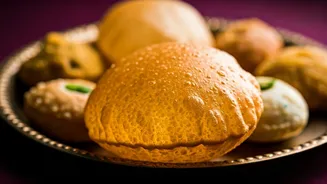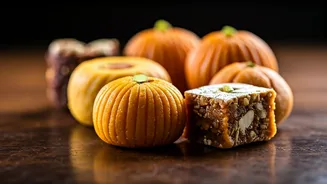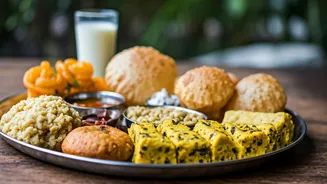Spice Routes & Origins
Indian cuisine, a vibrant tapestry of flavors and aromas, owes its richness to the historical spice trade that connected the Indian subcontinent with the rest
of the world. The early interactions introduced exotic ingredients to the region, and also helped establish a sophisticated culinary identity, which was further developed by the diverse influences of various rulers and cultures over millennia. The availability of diverse spices such as turmeric, cumin, coriander, and cardamom, played a pivotal role in the evolution of Indian food, and they are not just ingredients; they are the soul of numerous dishes. They provided depth and complexity to the meals. Moreover, the cultural significance of food and the techniques used in Indian cooking are closely related to the religious practices, social customs, and economic conditions of different regions within India.
Regional Culinary Diversity
India's varied geography and climate have fostered a remarkable diversity in its cuisine. Each region boasts its own distinctive dishes, reflecting local ingredients and culinary traditions. North Indian cuisine, influenced by Mughal traditions, is known for its rich curries, creamy sauces, and the use of tandoor ovens. South Indian food often features rice-based dishes, coconut milk, and a generous use of spices like curry leaves and mustard seeds. West Indian cuisine, especially from the coastal areas, showcases seafood specialties and the use of coconut, while the east has a unique blend of flavors from both Bengali and tribal traditions. This regional diversity is a cornerstone of Indian cuisine, providing a variety of taste experiences that keep the culinary landscape ever changing.
Spices: The Flavor Architects
Spices are the heart of Indian cuisine, infusing each dish with unique flavors and aromas. The skillful blending of spices is an art form, with each combination imparting a specific taste profile. Turmeric adds a golden hue and a subtle earthy taste, while cumin offers warmth and a hint of bitterness. Coriander provides a fresh, citrusy note, and cardamom contributes a sweet, aromatic fragrance. These spices are not just for flavor; many have medicinal properties, contributing to the holistic nature of Indian cooking. Chefs and home cooks alike carefully measure and mix spices, creating layers of flavor that define the Indian food experience. The complexity of the spice combinations reflects the history and cultural richness of India.
Cooking Methods Unveiled
Indian cooking employs a range of techniques, each contributing a unique flavor and texture. Grilling in a tandoor oven, a clay oven heated by charcoal, is a traditional method that imparts a smoky flavor to meats and breads. Stir-frying is common in various regions, and it allows for quick cooking with high heat. Slow cooking is an important method for developing rich, complex flavors in curries and stews. Frying is used for creating crispy snacks and dishes. The skillful use of cooking methods, combined with the careful selection and use of spices, results in a wide array of textures and tastes. From the sizzling of a tadka (tempering) to the gentle simmer of a curry, each cooking method plays a crucial role in delivering the diverse flavors of Indian cuisine.
Food's Cultural Significance
Food in India holds deep cultural significance, extending far beyond basic nourishment. Meals are often social events, bringing together families and communities. The preparation and sharing of food can be a celebration of festivals, weddings, and other significant occasions. The ritualistic aspects of eating, such as offering food to deities or honoring guests, highlight the respect and reverence associated with food. Moreover, food habits and customs differ greatly across the country, linked to religious practices, caste systems, and local traditions. The way food is prepared and eaten reflects the cultural diversity and the rich heritage of India. Food acts as a connector, strengthening social bonds and celebrating cultural identities.
